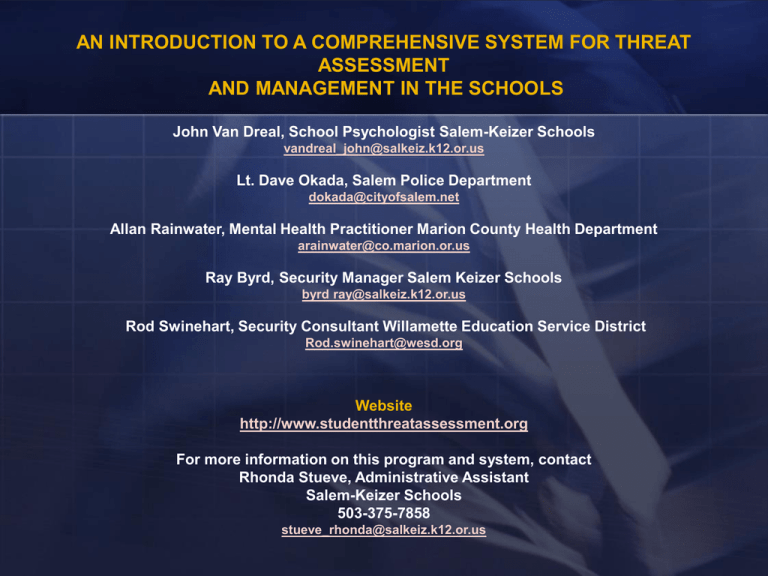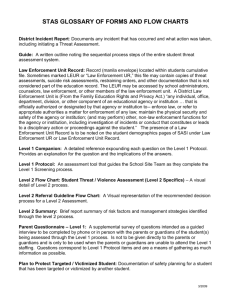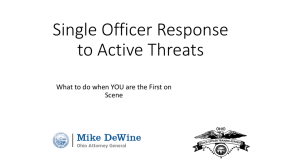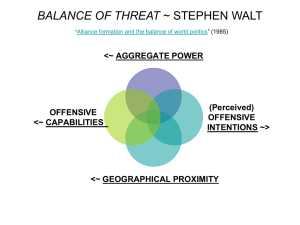Threat Assessment and Management in Schools
advertisement

AN INTRODUCTION TO A COMPREHENSIVE SYSTEM FOR THREAT ASSESSMENT AND MANAGEMENT IN THE SCHOOLS John Van Dreal, School Psychologist Salem-Keizer Schools vandreal_john@salkeiz.k12.or.us Lt. Dave Okada, Salem Police Department dokada@cityofsalem.net Allan Rainwater, Mental Health Practitioner Marion County Health Department arainwater@co.marion.or.us Ray Byrd, Security Manager Salem Keizer Schools byrd ray@salkeiz.k12.or.us Rod Swinehart, Security Consultant Willamette Education Service District Rod.swinehart@wesd.org Website http://www.studentthreatassessment.org For more information on this program and system, contact Rhonda Stueve, Administrative Assistant Salem-Keizer Schools 503-375-7858 stueve_rhonda@salkeiz.k12.or.us Soon to be published book Titled: Assessing Student Threats: A Handbook for Implementing the SalemKeizer System. Edited by John Van Dreal If you'd like to purchase copies, you may do so in advance at the following contacts. Price will be approximately $23 for paperback and $50 for hardcover. Rowman and Littlefield (800) 462-6420. email orders@rowman.com. website http://www.rowmanlittlefield.com/ Threat Advisory Teams *Marion County Sheriff’s Office *Salem Police Department Oregon State Police Keizer Police Department *Marion County District Attorney’s Office Salem-Keizer School District Willamette Educational Service District Marion County Health Department Marion County Risk Management Marion County Juvenile Department Oregon Youth Authority Associate Members Chemeketa Community College Willamette University US Dept Of Veterans Affairs State Courts-Marion County Corban University ADVANTAGES OF A THREAT ASSESSMENT SYSTEM • Shared ownership, shared responsibility. Decreased liability. • Multi-discipline, multi-agency. • Expeditious but methodical. • Community collaboration and ownership. • Identification of risk in clear terms. • Interventions and supervision strategies that fit the situation and accurately address risk. • Promotes observation and supervision. Student system safely keeps many students in school who would otherwise be removed through expulsion or by other means. • Increases both the physical safety of a school and the psychological sense of safety. STUDENT THREAT ASSESSMENT and MANAGEMENT SYSTEM Systems Flow Chart Referral Release Custody Adjudication Law Enforcement On going information sharing between Law Enforcement and Threat Assessment Process Level 2 Assessment Student Threat Assessment Level 1 Screening Site Team Act of Violence or Implied Threat of Violence Initiate Protective Response if imminent danger to others Contact Law Enforcement, Level Operations, and Security Department • • • • Administrator Counselor Law Enforcement (SRO) Others who know the student (Teachers, Coaches, Special Ed./504 Case Manager, etc.) • Campus Monitor • Parent (As circumstances allow) Administrator and Counselor / Law Enforcement Officer (SRO) determine need for Level 1 Screening Unfounded Concerns Team • • • • • • • • School Districts Law Enforcement Public Mental Health Juvenile Justice State Youth Authority State Court Security District Attorney’s Office Others, Case Specific– Protective services, disability case managers, etc. Plan / Recommendations • • • • Plan / Recommendations Monitoring Behavior Modification Intervention Increase Supervision Referral • • • • • Increase Supervision Monitoring Intervention Placement Referral • • Community Resources Mental Health Evaluation Ongoing information sharing between protective response & Threat Assessment Team Team Principles • “FIRST WE DO NO HARM“ • • • • • • • • Arrest/Jail is not always the best option! The team does not manage cases Control of the case remains with the presenting agency The team is advisory only We do not assess people, we assess situations The team does not generate reports The team does not profile Confidentiality!!!! ORGANIZING A SYSTEM • Need, justification and authorization. • Community ownership, commitment, and responsibility. • Policy and procedures necessary for functioning. (Legal counsel) • Organize resources, design system and refine. • Training, implementation, more training. • Maintenance of program, trouble-shooting and ongoing training. Choosing Team Members (Modified from US Dept of Ed. and USSS) • An ability to relate well to others. • An awareness and sensitivity to the difference between harming and helping in an intervention. • A reputation for fairness and trustworthiness. • A questioning, analytical and even skeptical mindset. • Training in the collection and evaluation of information from multiple sources. • Discretion and an appreciation for the importance of keeping information confidential. • Familiarity with the contemporary issues of school and community safety. • The ability to serve as a formal link or liaison between various systems (a “boundary spanner”, a “team player” who believes in the project and the process.) • In-depth knowledge about their own organization, resource availability, and both political and ethical boundaries. (No car-salesmen needed.) • Full credibility and respect within their own organization. 94% of administrators stated that: • STAT effectively identified potentially dangerous students and situations. • STAT had positive effects on school safety. • STAT provided important information necessary for support, discipline, and placement decisions. • STAT fulfills a valuable role in schools. In the same survey, 90% of administrators reported that STAT increased efficient coordination with law enforcement and mental health.











